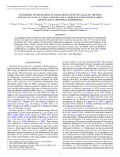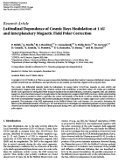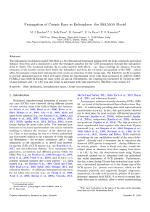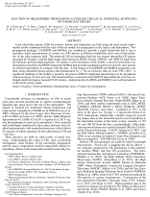Cosmic rays diffusion through the interplanetary medium is described by a diffusion tensor (\(K_{ij}\)) that, in a reference system co-moving with the IMF irregularities, can be parametrized as [see e.g. Jokipii 1971 and reference therein]:
\begin{equation}\label{eq:Kmag}
K_{ij}=\left [\begin{array}{ccc}
K_{||} & 0 & 0 \\
0 & K_{\perp,2} & K_A \\
0 & -K_A & K_{\perp,3}
\end{array}\right ]
\end{equation}
with \( K_{||}\) the diffusion coefficient describing the diffusion parallel to the average magnetic field; \(K_{\perp,3}=K_{\perp,r}\) and
\(K_{\perp,2}=K_{\perp,\theta}\) are the diffusion coefficient describing the diffusion perpendicular to the average magnetic field in the radial and polar directions respectively, and finally \(K_A\) is the so-called antisymmetric diffusion coefficient described the Magnetic drift across the large scale magnetic field.
A complete parametrization of diffusion coefficients from low to high rigidities is still an open question, but it is common accepted that:
a) at higher rigidity the diffusion coefficient should have a quasi-linear dependence, and b) the diffusion coefficient should be more ``flat'' at lower rigidity [see, e.g., Palmer 1982].
From HelMod version 3.0 (Boschini et al 2017a,Boschini et al 2017b), for rigidity greater than 1 GV, we use:
\begin{equation}\label{EQ::KparActual}
K_{||}=\frac{\beta}{3} K_0\left( \frac{P}{1\text{GV}}+g_{low}(t)\right) \left(1+\frac{r}{\text{1 AU}}\right),
\end{equation}
where \(K_0\) is the diffusion parameter - described in Section 2.1 of Bobik et Al 2012 -, which depends on solar activity and polarity, \(\beta\) is the particle speed in unit of speed of light, \(P=qc/|Z|e\) is the particle rigidity expressed in GV, \(r\) is the heliocentric distance from the Sun in AU and, finally, \(g_{low}\) is a constant that describes the smoothness of the transition and decrease to 0 during high activity periods.
In present model the spatial dependence is consistent with the one used in Bobik et al 2013 to describe CR latitudinal gradients and shows a radial dependence proportional to \(r\), but no latitudinal dependence.
The perpendicular diffusion coefficient is taken to be proportional to \(K_{||}\) with a ratio
\(K_{\perp,i}/K_{||}=\rho_i\) for both \(r\) and \(\theta\) \(i\)-coordinates.



